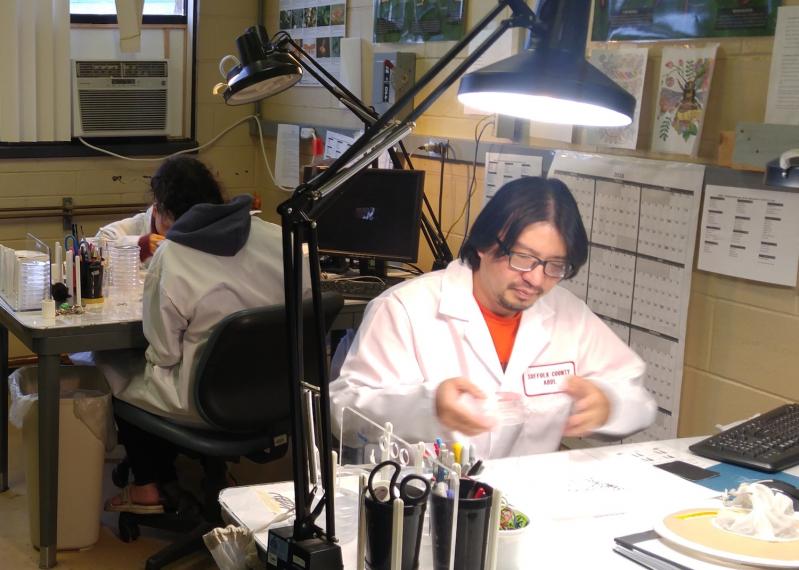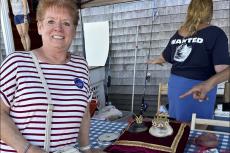The reports come on an almost weekly basis from the Suffolk County Department of Health Services: mosquitoes and dead birds testing positive for the presence of West Nile virus. As of last Thursday, 92 mosquitoes and three birds have turned up with positive results, largely in western parts of Suffolk.
So far this summer, while Manorville, Riverhead, Southold, and Aquebogue have each had at least one positive result, South Fork communities have been absent from these reports.
“The more rural settings tend to have the least amount of virus activity,” said Chris Romano, who oversees the county’s blood-borne disease lab. “We tend to see the most virus centered around urban areas. New York City is breaking records left and right when it comes to the virus, and in Suffolk County we tend to see it in the western parts.”
But that’s not to say the South Fork is immune; experts are saying it’s only a matter of time before infected mosquitoes turn up in the county Health Department’s traps in Montauk, East Hampton, and Bridgehampton.
“Historically, what we see is a start with West Nile virus in the west end of Suffolk County and a slow progression of activity moving eastward,” Mr. Romano said. “We’re still only halfway through the season. I would expect to see some West Nile virus activity in our traps in the coming weeks.”
The county tests up to 100 mosquito samples from its traps each week. On July 30, the Health Department announced 40 of those had tested positive the week prior. “That’s a pretty big percentage,” Mr. Romano said.
West Nile virus, which was first detected in the county in 1999, can be transmitted to humans through the bite of an infected mosquito. Most people who come down with the virus experience no symptoms or mild ones, but some cases can be more severe, with symptoms including fevers, headaches, neck stiffness, disorientation, tremors, muscle weakness, and numbness.
The case counts vary widely, according to county data. In 2023, five people in Suffolk came down with the virus. The year prior, 11 people were infected. In 2010, 25 cases were diagnosed. The majority of these cases occurred in people ages 50 and up. Yesterday, the county announced it has confirmed the first virus human case of 2024, impacting an Islip Town resident over age 50.“The confirmation of West Nile virus in mosquito samples indicates the presence of West Nile virus in the area,” said Dr. Gregson Pigott, commissioner of the County Health Department. “While there is no cause for alarm, we advise residents to cooperate with us in our efforts to reduce exposure to West Nile virus and other mosquito-borne diseases.”
The county often uses aerial spraying methods to target mosquito hotspots but has not yet had to do this widely, so far this season, in East Hampton Town.
“That’s because there hasn’t been any detected West Nile virus activity,” Mr. Romano explained. “That’s the kind of thing that would prompt them to intervene if necessary. Without a risk detected yet, they haven’t been considering spraying on the South Fork.”
John Aldred, a member of the East Hampton Town Trustees, said the town has helped the county locate mosquito breeding sites for targeted spraying in the past, for instance in the Accabonac marshlands. Through a partnership with the Nature Conservancy, a scouting group goes out about every two weeks, paying particular attention during new moon and full moon events, “when the tides are highest and the likelihood of triggering a hatch of mosquitoes is highest,” Mr. Aldred said.
“That way, if what we find is necessary to treat, they can just treat the breeding spots,” he continued, “whereas prior to that, if they determined there was a hatch going on and there were mosquitoes imminently hatching out, they would just spray the whole marsh.”
Mr. Aldred and his fellow mosquito hunters keep it simple, with equipment amounting to a dipper (“a little cup on the end of a stick,” he said) and a cellphone. They follow the edges of the marsh, scooping up samples to observe the types and counts of larvae, and record the survey location using the phone’s GPS.
“The smaller stages of the larvae are able to be treated with B.T.I., bacillus thuringiensis Israeli, a bacterium that is specific to the mosquito gut. It interrupts their processing of food and kills them that way, so it’s only targeting mosquitoes,” Mr. Aldred said. “The latter stages [of larvae] are only successfully treated with a chemical called Methoprene, which is more problematic for impacting other organisms.” One example is dragonflies; according to Nicole Maher, a senior coastal scientist with the Nature Conservancy, the dragonfly population has rebounded in the marshlands.
The long-term goal, Ms. Maher said, “is to restore the hydrology at these breeding hotspots so that the county doesn’t need to spray at all and so that the marsh can grow vertically and migrate landward to keep up with sea level rise.”
The group is also working with the Peconic Estuary Partnership, Suffolk County, and “an innovative team of salt marsh restoration practitioners” to design “minimally disruptive restoration plans to return marsh function and simultaneously reduce the need for chemical control of mosquitoes,” Ms. Maher said.
These efforts also save Suffolk County money and boost transparence, she added. “We have been applying for grants and anticipate funding to implement these restoration plans” on publicly owned lands, as well as those controlled by the Nature Conservancy, “within the harbor as soon as the required permits are in place.”
Mr. Romano said that even if a community has not had a report of a positive mosquito sample, people should take precautions to protect their health.
“There are a lot of things we can do. We ask people to consider using repellents, such as what’s listed on the Centers for Disease Control website,” he said. “We ask people to not be outdoors at dawn or dusk when mosquito activity is at its peak. Wear pants or long sleeves to reduce bites. On your patio, a simple trick is to run a fan to blow away the mosquitoes.”
He also urges people to address standing water in their yards, particularly after heavy rains or after a sprinkler has been used for irrigation. “Flower pots, children’s toys, pet bowls, clogged gutters, bird baths — dump that water at least once a week and make sure it’s clean,” Mr. Romano said. “If you can reduce that standing water you can reduce the mosquitoes on your property.”
Dead birds are another story, he said. They should be reported to the county, which will come to collect the bird in question. The hotline to call is 631-852-5999.




